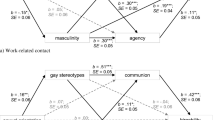Abstract
In this article the linkages between upward influence tactics and salary attainment were studied within the context of observed salary differences between men and women. The data for this field study were gathered from 212 male and 82 female business school graduates. Annual salary was regressed on a set of control variables and six dimensions of upward influence. Separate salary equations were estimated for men and women, and used to study sex-based salary differentials. The results indicated that even though there were few mean differences between men and women in terms of person-centered attributes, the characteristics of employing organizations, or the use of upward influence styles, women earned less than men. The set of upward influence tactics uniquely accounted for variation in salaries for both men and women, and there was evidence of gender specificity in the salarly allocation process. The usefulness of considering upward influence tactics when studying the salary allocation process is emphasized, particularly when the goal is to understand observed salary differences between men and women.
Similar content being viewed by others
References
Allen, R. W., & Porter, L. W. Organizational influence processes. Glenview, IL: Scott Foresman, 1983.
Bacharach, S. B., & Lawler, E. J. Power and politics in organizations. San Francisco, CA: Jossey-Bass, 1980.
Baysinger, R. A., & Youngblood, S. A. The role of gender and the determinants of salary: An empirical study. Presented at the meeting of the Academy of Management, Anaheim, CA, August 1988.
Betz, N. E., & Fitzgerald, L. F. The career psychology of women. Orlando, FL: Academic Press, 1987.
Bloch, F. E., & Kuskin, M. S. Wage determination in the union and nonunion sectors. Industrial and Labor Relations Review 1978, 31 183–192.
Dreher, G. F. Nonrespondent characteristics and respondent accuracy in salary research. Journal of Applied Psychology 1977, 62 773–776.
Dreher, G. F., Dougherty, T. W., & Whitely, B. Generalizability of MBA degree of socioeconomic effects on business school graduates' salaries. Journal of Applied Psychology 1985, 70 769–773.
Filer, R. K. Male-female wages differences: The importance of compensating differentials. Industrial and Labor Realtions Review 1985, 38 426–437.
Freedman, S. M., & Montanari, J. R. An integrative model of managerial reward allocation. Academy of Management Journal 1980, 5 381–390.
Gabarro, J. J., & Kotter, J. P. Managing your boss. Harvard Business Review 1980, 58 92–100.
Gould, S., & Penley, L. E. Career strategies and salary progression: A study of their relationship in a municipal bureaucracy. Organizational Behavior and Human Performance 1984, 34 244–265.
Hodson, R., & England, P. Industrial structure and sex differences in earnings. Industrial Relations 1986, 25 16–32.
Johnson, P. Women and power: Toward a theory of effectiveness. Journal of Social Issues 1976, 32 99–110.
Kanter, R. M. Men and women of the corporation. New York: Basic Books, 1977.
Kemp, A. A., & Beck, E. M. Equal work, unequal pay: Gender discrimination within work-similar occupations. Work and Occupations 1986, 13 324–347.
Kipnis, D., Schmidt, S. M., & Braxton- Brown, G. The hidden costs of persistence in upward influence. Unpublished manuscript, 1987.
Kipnis, D., Schmidt, S. M., & Wilkinson, I. Intraorgaizational influence tactics: Explorations in getting one's way. Journal of Applied Psychology 1980, 65 440–452.
Lawler, E. E. Pay and organizational effectiveness: a psychological view. New York: McGraw-Hill, 1971.
Nieva, V. F., & Gutek, B. A. Women and work: A psychological perspective. New York: Praeger, 1981.
Olson, J. E., & Frieze, I. H. Income determinants for women in business. In A. H. Stromberg, L. Larwood, & B. A. Gutek (Eds.). Women and work: An annual review Vol. 2, Beverly Hills, CA: Sage, 1986.
Pfeffer, J. Power in organizations. Marshfield, MA: Pitman Publishing, 1981.
Porter, L. W., Allen, R. W., & Angle, H. The politics of upward influence in organizations. In B. Staw, & L. Cummings (Eds.), Research in organizational behavior Vol. 2. Greenwich, CT: JAI Press, 1981.
Schilit, W. K., & Locke, E. A. A study of upward influence in organizations. Administrative Science Quarterly 1982, 27 304–316.
Author information
Authors and Affiliations
Rights and permissions
About this article
Cite this article
Dreher, G.F., Dougherty, T.W. & Whitely, W. Influence tactics and salary attainment: A gender-specific analysis. Sex Roles 20, 535–550 (1989). https://doi.org/10.1007/BF00288200
Issue Date:
DOI: https://doi.org/10.1007/BF00288200




